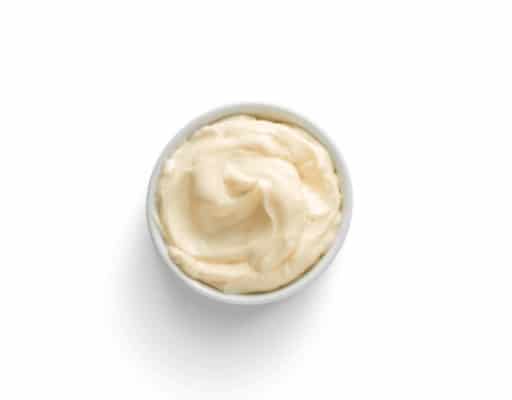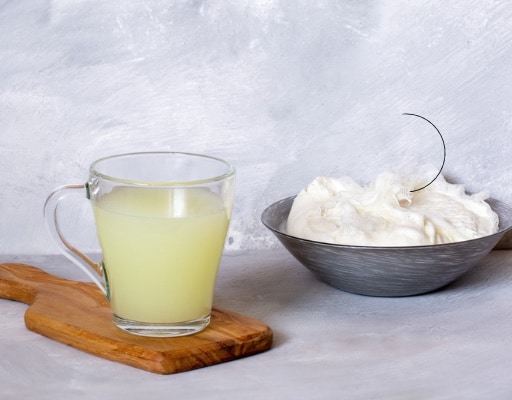We’ve all come to embrace the joys of whipping up dishes in our kitchens, and it’s no wonder that many of us have taken a liking to preparing condiments such as mayonnaise at home.
There’s something incredibly satisfying about transforming simple ingredients into a rich and creamy creation, then adding a touch of our own flair along the way.
But the curse of the homemade creations still remains alive and is here to stay: that things whipped up at home never boast an extended shelf life as commercially produced goods.
Homemade Mayo is the case we’re studying today, and we want to find out how long it lasts in the fridge and outside and what you can do to make it last longer.

Does Homemade Mayo Go Bad?
Homemade mayo, just like any other fresh product, can indeed go bad over time, and it does so faster than store bought mayonnaise: both inside and outside the refrigerator.
You might ask why? But in order to understand that, let’s first examine the differences between the two.
Homemade mayonnaise is typically made using raw eggs, oil (such as olive or canola), seasoning such as pepper and mustard and lemon juice, salt and/or vinegar to provide some acidity that makes the medium inhospitable for bacterial growth.
Store-bought mayonnaise on the other hand, often contains additional preservatives such as EDTA, potassium sorbate or sodium benzoate, which help prolong its shelf life by adding to the already existing preservative mechanisms of “lowered pH” provided by vinegar, lemon juice and salt.
Now let’s study a bit closer to find out the factors that make homemade mayo have a comparatively shorter life span?
Raw eggs
One of the primary ingredients in homemade mayo is raw eggs (and most of the time, they aren’t pasteurized unlike with store-bought Mayo), thus posing a higher risk of introducing bacteria such as Salmonella into your mixture right from the start.
Lack of sufficient chemical preservatives
As we had seen already, homemade mayonnaise generally omits synthetic additives found in many commercially produced products – this natural approach undoubtedly appeals to those who prefer chemical-free ingredients but compromises on longevity due to quicker degradation.
Storage conditions
As it lacks additional protective elements like preservatives, homemade mayonnaise relies heavily on its slightly acidic medium (which in itself, isn’t sufficient) and super careful handling (which isn’t entirely possible) to store safely.
So because of these things, Homemade mayo last only for a short time on the counter and when stored inside the fridge.
How Long Is Homemade Mayo Good For?
The lifespan of homemade egg mayo varies significantly based on whether it is stored outside or in the refrigerator.
Outside
Leaving homemade egg mayo at room temperature can cause rapid spoilage due to the presence of raw eggs and the lack of added preservatives.
You might think that the medium is acidic, but it isn’t so to the point where it can halt all bacterial activities completely, and for an extended duration.
Thus, it is not safe to leave your homemade mayonnaise unrefrigerated for any length of time; bacteria growth accelerates exponentially once left at warmer temperatures (like 90°F), and consuming mayo that has been exposed to room temperature for an extended period could pose a risk of foodborne illness.
In The Fridge
When properly stored in an air-tight container inside a refrigerator set at or below 40°F (4°C), homemade mayo can last up to 2 weeks.
It’s not magic that is happening, it’s the cooler environment that slows down bacterial growth and helps maintain its freshness better than when kept outside.
You should however, keep in mind that refrigerating your mayonnaise only slows down (and not stops) bacterial activity.
So always inspect your mix visually or by smell before consuming, as safety still remains a top priority with perishable food items like this.
Can You Freeze Homemade Mayonnaise?
It’s generally not recommended to freeze homemade mayonnaise as it tends to separate when frozen and defrosted due to the breakage of the emulsion, and fixing that can be notoriously challenging.
When you freeze it, the emulsion breaks and after thawing, it often becomes clumpy or separated instead of maintaining its creamy consistency, and you’ll find it difficult to work with the Mayo unless you’re using it for something other than a spread or dip.
How To Make Homemade Mayonnaise Last Longer?
If you want to preserve the shelf life of your homemade mayonnaise, then there’s really only one option you can try, and it’s the most unpleasant to hear — ferment it!
Yes, you heard that right. Mayonnaise can be fermented, and safely consumed at the same time.
You can ferment mayonnaise by the addition of acid whey — the pale yellow liquid derived from acid based dairy products like strained yogurt.

On its own, It works so well because it contains lactic acid bacteria that helps feed on the sugars and other components in the mayonnaise to drop the pH below a certain level that harmful bacteria won’t be able to survive, therefore offering stability to the mayonnaise and depending on how big of a pH plunge it is, change the taste from neutral to really tangy.
Making fermented mayonnaise is quite easy, simply add a few tablespoons of whey culture into your homemade mayo recipe, about 1 to 2 tablespoons, and mix. You can add it as you make the egg mixture right before adding in the oil, or after adding in the oil and making a stable emulsion.
Once mixed, allow the mayonnaise to sit at room temperature for 6 to 8 hours to give room for the lactic acid bacteria to work their magic.
After fermenting, refrigerate the mayonnaise and it should last for at least 1 month.
General Tips For Making Homemade Mayonnaise Last Longer
While you can certainly use whey to prolong the shelf life of your homemade Mayonnaise, not everyone would buy or like the idea, primarily because it could end up affecting the taste of your Mayonnaise as it stores.
In that case, you should rely then, on the basics of Mayo making to make sure your Mayo at least fully stretches to its 2 weeks lifespan.
Here are some tips to help your homemade mayo last longer and stay fresh.
Use Fresh And High Quality Ingredients
It is important to start with fresh eggs and use pasteurized egg yolks if possible to reduce the risk of contamination which can cause quick spoilage. Besides, fresh eggs would provide more lecithin than older ones and those improve the chances of making a successful emulsion.
Opting for high-quality oils like extra virgin olive oil or avocado oil can also help extend the shelf life of your mayonnaise.
Be Clean
Make sure all utensils, bowls and equipment are clean and sanitized before starting as it reduces the risk of introducing any harmful bacteria into your mayo. When retrieving anything from the Mayo also, make sure to use clean utensils as well and never dip your hand inside the Mayo which can introduce bacteria and cause quick spoilage.
Keep It Refriegrated
Always store your homemade mayonnaise in the refrigerator (not in the freezer, cause I’m pretty sure you’re not ready to deal with the repercussions) and at a temperature of 40°F (4°C) or below. This will slow down bacterial growth and help to preserve its freshness.
Proper Storage
Once your mayonnaise is prepared, transfer it to an airtight container and refrigerate, making sure the cover is placed tightly to limit exposure to air as much as possible.
In case you didn’t know, air is the chief cause of spoilage in perishable commodities like Mayo because it carries contaminants and can introduce them into any medium it finds its way into.
Keeping the cover shut at all times would help prevent this exposure and thus extend the shelf life of your mayo.
Make Your Mayonnaise With Acids
Adding an acid such as vinegar or lemon juice to your mayonnaise recipe can help to extend its shelf life by lowering the pH and creating a less hospitable environment for bacteria, exactly what the introduction of whey does, but in a more natural way.
Frequently Asked Questions
How Long Does Homemade Vegan Mayo Last?
Homemade vegan mayo (typically made without raw eggs) and featuring plant-based substitutes like aquafaba or soy milk, tends to have a slightly longer shelf life compared to traditional egg-based mayonnaise.
The reason is because it lacks raw eggs in it which reduces some of the risks of bacterial contamination as well as the overall susceptibility to spoilage due to how perishable eggs are, although not by a mile since some of the plant-based ingredients are also vulnerable to degradation over time.
When stored correctly in an airtight container within the refrigerator at or below 40°F (4°C), homemade vegan mayo can last anywhere from 14 to 28 days.
To ensure you’re consuming a fresh and safe homemade vegan mayonnaise, keep track of when you made it and always check for changes in color, texture or smell before using.
How Long Does Homemade Tuna Mayo Last?
Homemade tuna mayo can typically last for about 3 to 5 days when stored properly in an airtight container in the refrigerator.
To ensure freshness and safety, it’s best to consume it within this timeframe, and avoid leaving it out at room temperature for more than two hours, as bacteria can grow rapidly and spoil the food.
How To Make Homemade Mayonnaise Thicker
Try these few tricks to salvage a mayonnaise that has become runny, and follow the tips below to ensure that you always have a thick and creamy emulsion whenever you make mayonnaise.
- Always follow the recipe instructions as it is. Do not deviate.
- Always use room temperature ingredients, and make sure they’re fresh and high quality.
- Try making Mayo with a hand blender or food processor. Sometimes, a more powerful mixing tool can help incorporate more air into the mixture, resulting in a thicker mayonnaise.
- Try refrigerating the Mayo if it is only slightly runny, as it may then corn up a bit in the fridge. If you have a super runny Mayo, just follow the trick in the article.
How To Make Homemade Light Mayonnaise
To make a lighter version of homemade mayonnaise, you need to reduce the overall quantity of the oil and egg used (as those are the chief source of calories as well as fat), and supplement with something else that is light to keep the bulk of the Mayo.
Typically, you would rely on water or something like Greek yogurt that is much healthier.
You can also just make spicy Mayo with Greek yogurt as the alternative to Mayo in the recipe. It works well!
Here’s how to make homemade light mayonnaise
Ingredients:
- 1/2 cup neutral oil (such as vegetable, canola, or sunflower oil)
- 1/2 to 1 cup Greek yogurt
- 1 large egg yolk, preferably pasteurized
- 1 tablespoon lemon juice or white vinegar
- 1 teaspoon dijon mustard
- Salt
- Black pepper
Instructions
- Whisk together the egg yolk, lemon juice or vinegar, dijon mustard, salt and pepper until well combined.
- Slowly drizzle in the oil while continuously blending or whisking the mixture to create an emulsion.
- Fold in the Greek yogurt and mix until smooth and creamy.
- Taste and adjust seasoning if necessary.

